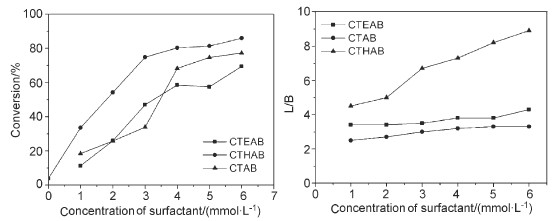| [1] Kuntz, E. G. CHEMTECH 1987, 17(9), 570. [2] Yuan, M. L.; Chen, H.; Li, R. X.; Li, Y. Z.; Li, X. J. Appl. Catal. 2003, 251, 181. [3] Tilloy, S.; Genin, E.; Hapiot, F.; Landy, D.; Fourmentin, S.; Genet, J. P.; Michelet, V.; Monflier, E. Adv. Synth. Catal. 2006, 348, 1547. [4] Chen, H.; Li, Y. Z.; Chen, J. R.; Cheng, P. M.; He, Y. E.; Li, X. J. J. Mol. Catal. A: Chem. 1999, 149, 1. [5] Naziruddin, A. R.; Hepp, A.; Pape, T.; Hahn, F. E. Organometallics 2011, 30, 5859. [6] Fu, H. Y.; Yuan, M. L.; Chen, H.; Li, R. X.; Li, X. J. Chin. J. Catal. 2010, 31, 251. (付海燕, 袁茂林, 陈华, 李瑞祥, 李贤均, 催化学报, 2010, 31, 251.) [7] Lü, S. F.; Huang, F. X.; Hu, B.; Qin, Y. H.; Zhang, X. Y. Speciality Petrochem. 2008, 25(6), 49. (吕顺风, 黄凤兴, 胡波, 秦燕璜, 张秀英, 精细石油化工, 2008, 25(6), 49.) [8] Ding, H.; Hanson, B. E.; Glass, T. E. Inorg. Chim. Acta 1995, 229, 329. [9] Giménez-Pedrós, M. D.; Aghmiz, A.; Claver, C.; Masdeu-Bultó, A. M.; Sinou, D. J. Mol. Catal. A: Chem. 2003, 200, 157. [10] Chaudhari, R. V.; Bhanage, B. M.; Deshpande, R. M.; Delmas, H. Nature 1995, 373, 501. [11] Kalck, P.; Dessoudeix, M.; Schwarz, S. J. Mol. Catal. A: Chem. 1999, 143, 41. [12] Jin, Z. L.; Zheng, X. L.; Fell, B. J. Mol. Catal. A: Chem. 1997, 116(2), 55. [13] Peng, Q. R.; Liao, X. L.; Yuan, Y. Z. Catal. Commun. 2004, 5, 447. [14] Goedheijt, M. S.; Hanson, B. E.; Reek, J. N. H.; Kamer, P. C. J.; van Leeuwen, P. W. N. M. J. Am. Chem. Soc. 2000, 122, 1650. [15] Liu, C.; Jiang, J. Y.; Wang, Y. H.; Cheng, F.; Jin, Z. L. J. Mol. Catal. A: Chem. 2003, 198, 23. [16] Ji, Z. J.; Jiang, J. Y.; Wang, Y. H. Chin. Chem. Lett. 2010, 21, 515. [17] Sueur, B.; Leclercq, L.; Sauthier, M.; Castanet, Y.; Mortreux, A.; Bricout, H.; Tilloy, S.; Monflier, E. Chem. Eur. J. 2005, 11(21), 6228. [18] Patrigeon, J.; Hapiot, F.; Canipelle, M.; Menuel, S.; Monflier, E. Organometallics 2010, 29, 6668. [19] Klosin, J.; Landis, C. R. Acc. Chem. Res. 2007, 40, 1251. [20] Sieffert, N.; Wipff, G. J. Phys. Chem. B 2006, 110(9), 4125. [21] Leclercq, L.; Schmitzer, A. R. Organometallics 2010, 29, 3442. [22] Leclercq, L.; Hapiot, F.; Tilloy, S.; Ramkisoensing, K.; Reek, J. N. H.; van Leeuwen, P. W. N. M.; Monflier, E. Organometallics 2005, 24, 2070. [23] Fu, H. Y.; Wang, X.; Yuan, M. L.; Li, Y. Z.; Chen, H.; He, Y. E.; Li, X. J. Chem. Res. Appl. 2003, 15, 332. (付海燕, 王霞, 袁茂林, 黎耀忠, 陈华, 何玉萼, 李贤均, 化学研究与应用, 2003, 15, 332.) [24] Miyagawa, C. C.; Kupka, J.; Schumpe, A. J. Mol. Catal. A: Chem. 2005, 234, 9. [25] Chen, H.; Li, Y. Z.; Chen, J. R.; Cheng, P. M.; Li, X. J. Catal. Today 2002, 74, 131. [26] Li, M.; Li, Y.; Chen, H.; He, Y. E.; Li, X. J. J. Mol. Catal. A: Chem. 2003, 194, 13. [27] Yuan, M. Y.; Chen, H.; Li, R. X.; Li, Y. Z.; Li, X. J. Catal. Lett. 2003, 94, 15. [28] Li, M.; Xu, B.; Chen, H.; He, Y. E.; Huang, X. Y.; Li, L. B.; Li, Y. Z.; Li, X. J. Chem. J. Chin. Univ. 2004, 25(4), 717. (李敏, 徐斌, 陈华, 何玉萼, 黄雪原, 李丽波, 黎耀忠, 李贤均, 高等学校化学学报, 2004, 25(4), 717.) [29] Chen, H.; Li, Y.; Chen, J.; Cheng, P.; He, Y.; Li, X. J. J. Mol. Catal. A: Chem. 1999, 149, 1. [30] Fu, H. Y.; Li, M.; Chen, H.; Li, X. J. J. Mol. Catal. A: Chem. 2006, 259, 156. [31] Fu, H. Y.; Li, M.; Mao, H.; Lin, Q.; Yuan, M. L.; Li, X. J.; Chen, H. Catal. Commun. 2008, 9, 1539. [32] Evan, D.; Osborn, J. A.; Wilkinson, G. J. Chem. Soc. A 1968, 3133. [33] Wu, J. C.; Yuan, G.; Zhou, Q. Z. Petrochem. Technol. 1991, 20, 79. (吴己丑, 袁刚, 周启昭, 石油化工, 1991, 20, 79.) [34] Chen, H.; Li, X. J.; Liu, H. C.; Li, Y. Z. CN 1179428, 1999. (陈华, 李贤均, 刘海超, 黎耀忠, CN 1179428, 1999). [35] Li, X. J.; Chen, H.; Li, Y. Z.; Liu, H. C. CN 1179429, 1999. (李贤均, 陈华, 黎耀忠, 刘海超, CN 1179429, 1999). |
